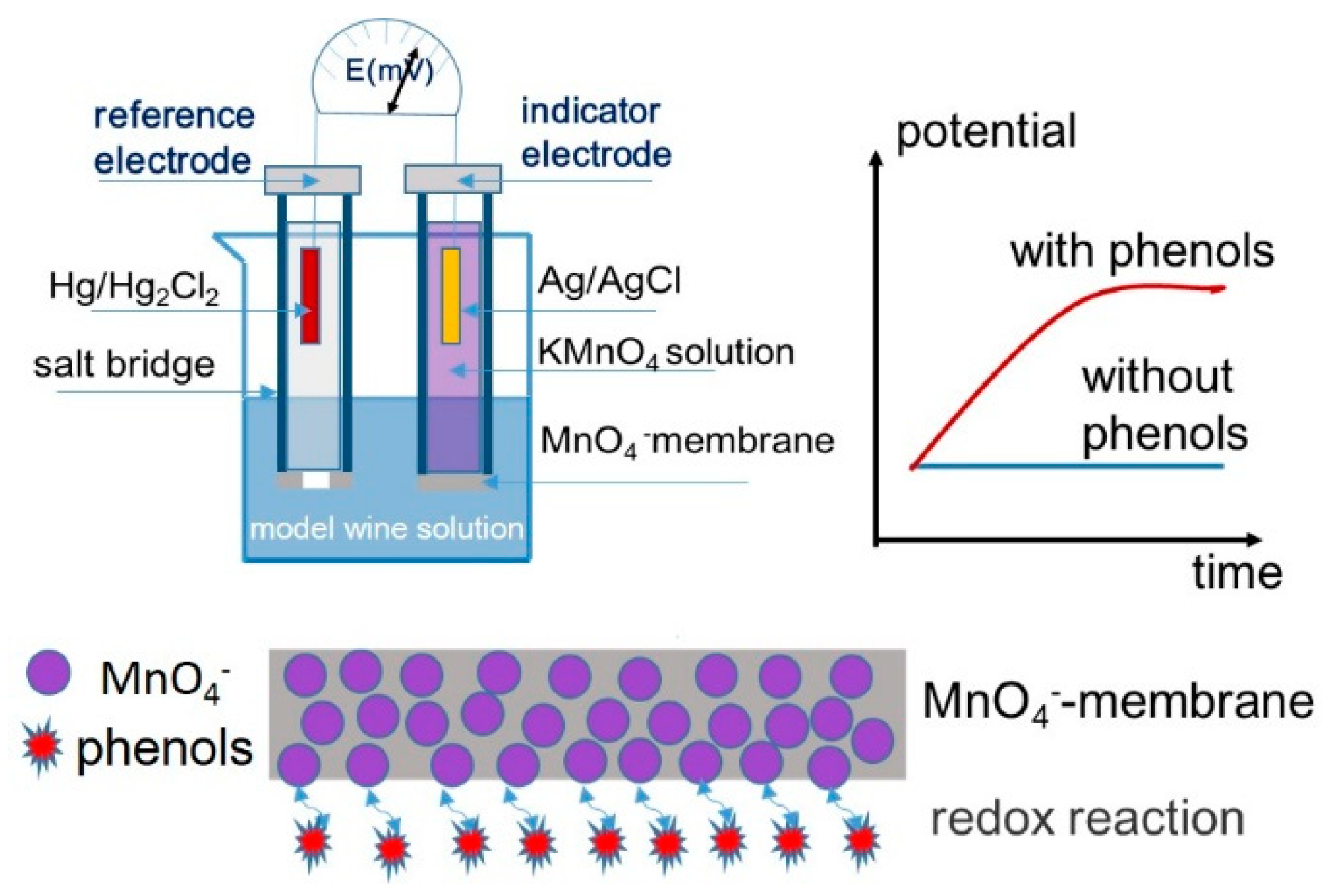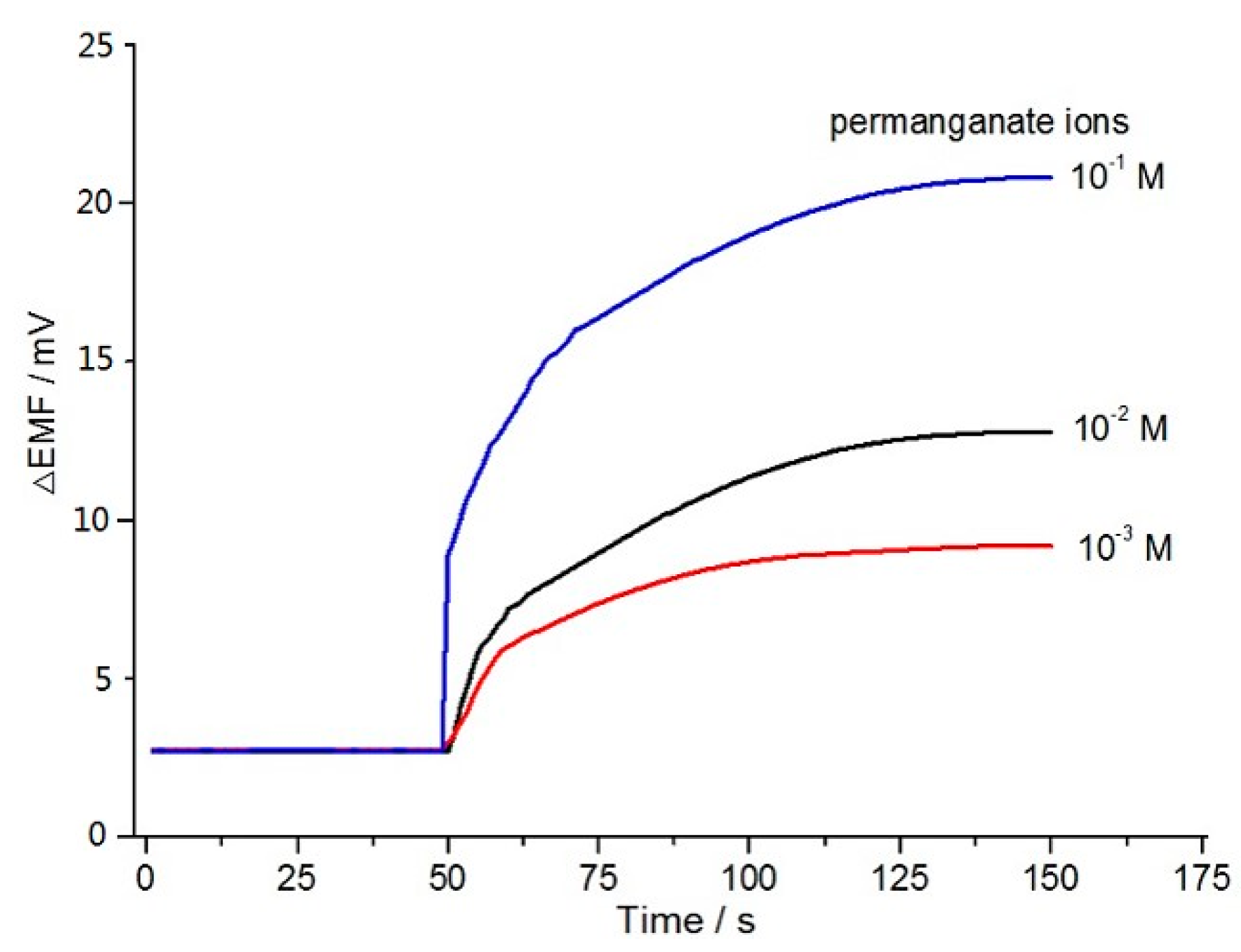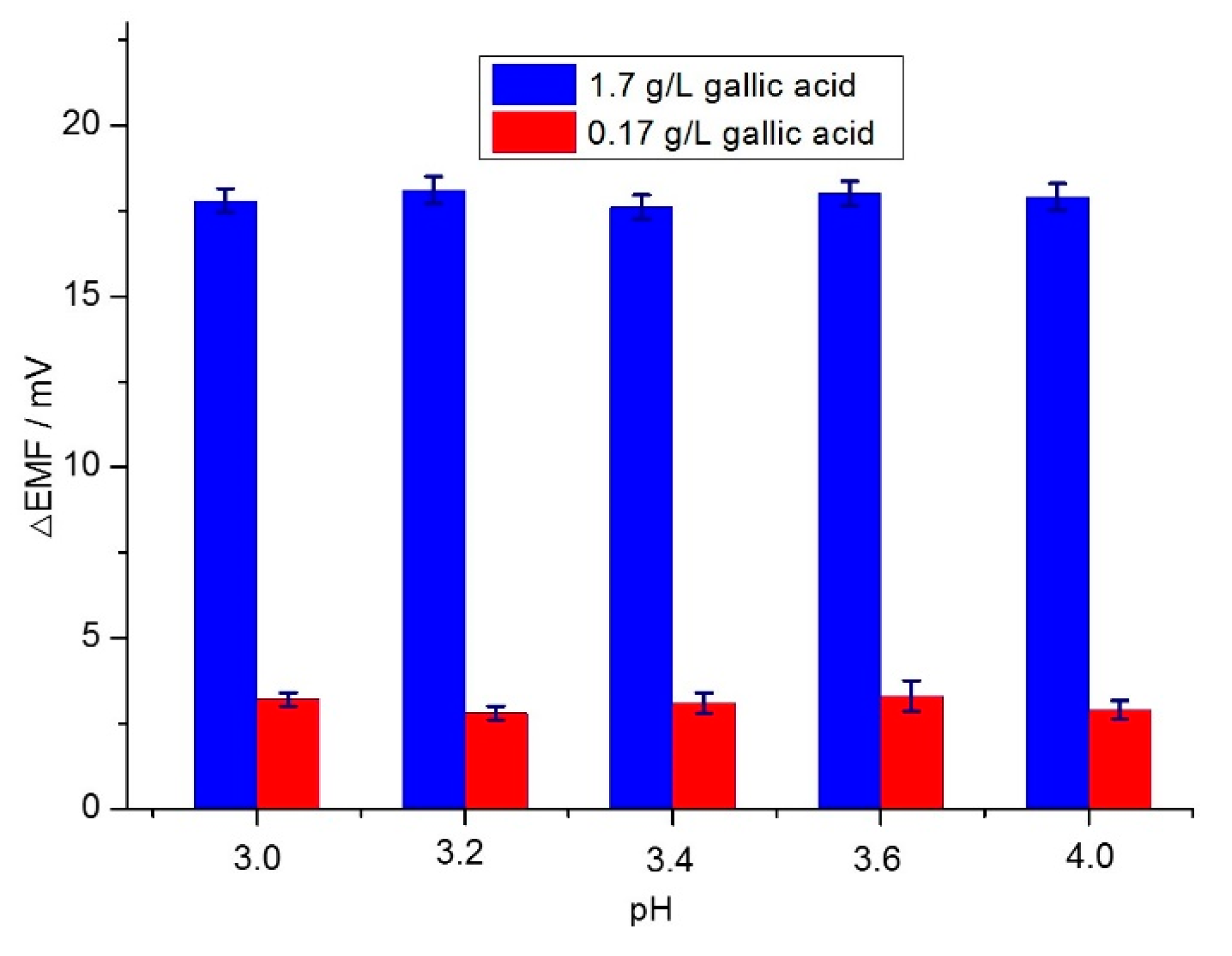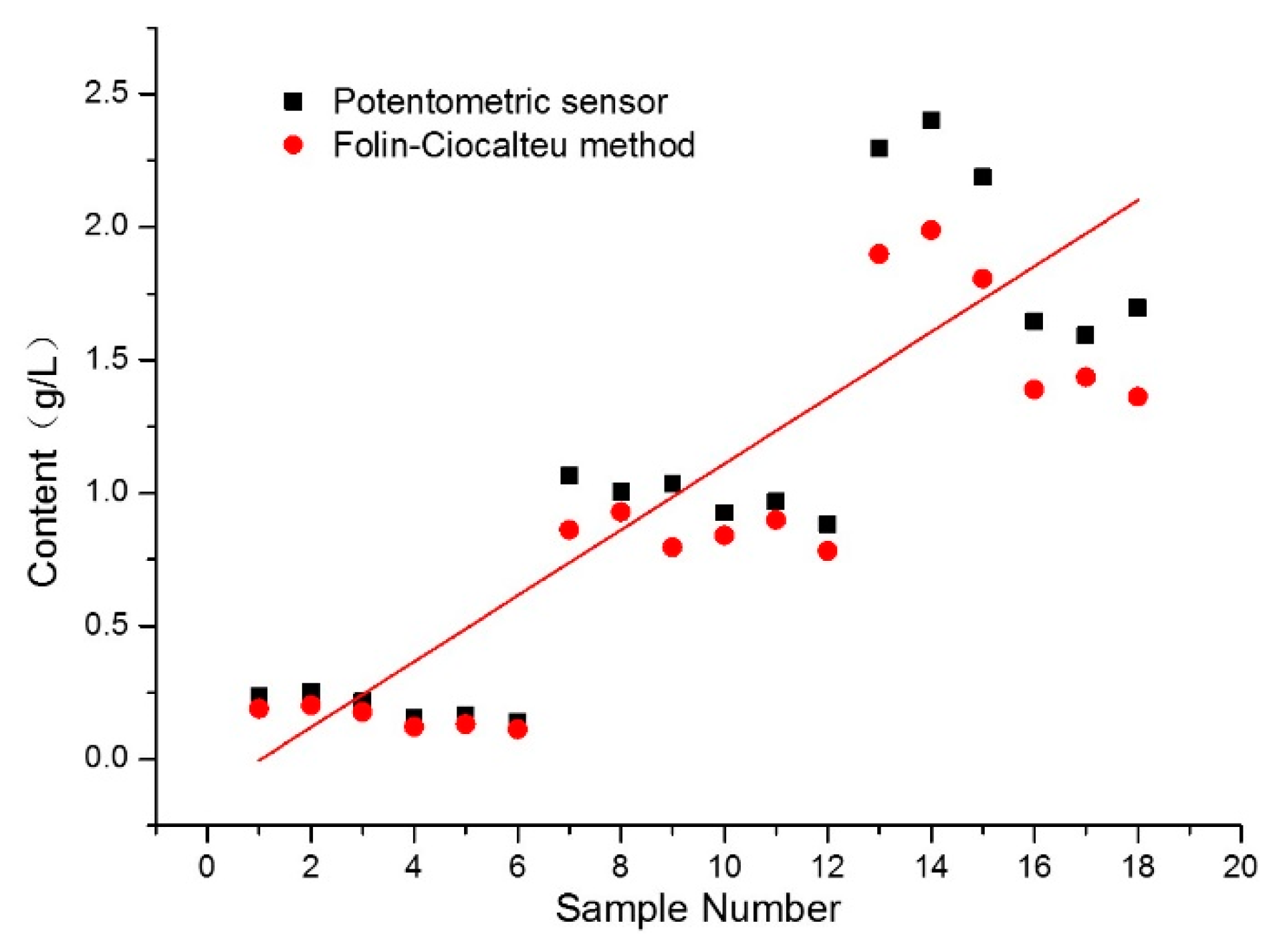Determination of the Total Phenolic Content in Wine Samples Using Potentiometric Method Based on Permanganate Ion as an Indicator
Abstract
1. Introduction
2. Results
2.1. Principle of Potential Response
2.2. Optimization of Analysis Conditions
2.2.1. Membrane Composition
2.2.2. Inner Filling Solution
2.2.3. pH
2.3. Characteristics of the Proposed Potentiometric Sensor
2.4. Analytical Application
3. Materials and Methods
3.1. Reagents and Materials
3.2. Potentiometric Sensor Preparation
3.3. Potentiometric Measurements
3.4. Application of Proposed Potentiometric Sensor
4. Conclusions
Author Contributions
Funding
Conflicts of Interest
References
- Lo Presti, R.; Carollo, C.; Caimi, G. Wine consumption and renal diseases: New perspectives. Nutrition 2007, 23, 598–602. [Google Scholar] [CrossRef] [PubMed]
- Nunes, C.; Freitas, V.; Almeida, L.; Laranjinha, J. Red wine extract preserves tight junctions in intestinal epithelial cells under inflammatory conditions: Implications for intestinal inflammation. Food Funct. 2019, 10, 1364–1374. [Google Scholar] [CrossRef] [PubMed]
- Gambacorta, G.; Trani, A.; Fasciano, C.; Paradiso, V.M.; Faccia, M. Effects of prefermentative cold soak on polyphenols and volatiles of Aglianico, Primitivo and Nero di Troia red wines. Food Sci. Nutr. 2019, 7, 483–491. [Google Scholar] [CrossRef] [PubMed]
- Cravero, M.C. Organic and biodynamic wines quality and characteristics: A review. Food Chem. 2019, 295, 334–340. [Google Scholar] [CrossRef] [PubMed]
- Nerantzaki, A.A.; Tsiafoulis, C.C.; Charisiadis, P.; Kontogianni, V.G.; Gerothanassis, I.P. Novel determination of the total phenolic content in crude plant extracts by the use of 1H NMR of the −OH spectral region. Anal. Chim. Acta 2011, 688, 54–60. [Google Scholar] [CrossRef] [PubMed]
- Maria Toledo-Martin, E.; del Carmen Garcia-Garcia, M.; Font, R.; Manuel Moreno-Rojas, J.; Salinas-Navarro, M.; Gomez, P.; del Rio-Celestino, M. Quantification of total phenolic and carotenoid content in blackberries (rubus fructicosus L.) using near infrared spectroscopy (NIRS) and multivariate analysis. Molecules 2018, 23, 3191. [Google Scholar] [CrossRef] [PubMed]
- Al Mughairy, B.; Al-Lawati, H.A.J.; Suliman, F.O. Characterization and application of nanocolloidal Mn(IV) in a chemiluminescence system for estimating the total phenolic content in pomegranate juices using a nanodroplet microfluidics platform. Sens. Actuators B Chem. 2018, 277, 517–525. [Google Scholar] [CrossRef]
- Cascant, M.M.; Sisouane, M.; Tahiri, S.; El Krati, M.; Cervera, M.L.; Garrigues, S.; de la Guardia, M. Determination of total phenolic compounds in compost by infrared spectroscopy. Talanta 2016, 153, 360–365. [Google Scholar] [CrossRef] [PubMed]
- Önder, F.C.; Ay, M.; Sarker, S.D. Comparative study of antioxidant properties and total phenolic content of the extracts of humulus lupulus L. and quantification of bioactive components by LC–MS/MS and GC–MS. J. Agric. Food Chem. 2013, 61, 10498–10506. [Google Scholar]
- Leitao, S.G.; Leitao, G.G.; Vicco, D.K.T.; Pereira, J.P.B.; Simao, G.D.; Oliveira, D.R.; Celano, R.; Campone, L.; Piccinelli, A.L.; Rastrelli, L. Counter-current chromatography with off-line detection by ultra high performance liquid chromatography/high resolution mass spectrometry in the study of the phenolic profile of Lippia origanoides. J. Chromatogr. A 2017, 1520, 83–90. [Google Scholar] [CrossRef] [PubMed]
- Draghi, P.F.; Fernandes, J.C.B. Label-free potentiometric biosensor based on solid-contact for determination of total phenols in honey and propolis. Talanta 2017, 164, 413–417. [Google Scholar] [CrossRef] [PubMed]
- Merkyte, V.; Morozova, K.; Boselli, E.; Scampicchio, M. Fast and simultaneous determination of antioxidant activity, total phenols and bitterness of red wines by a multichannel amperometric electronic tongue. Electroanalysis 2018, 30, 314–319. [Google Scholar] [CrossRef]
- Sekretaryova, A.N.; Volkov, A.V.; Zozoulenko, I.V.; Turner, A.P.F.; Vagin, M.Y.; Eriksson, M. Total phenol analysis of weakly supported water using a laccase-based microband biosensor. Anal. Chim. Acta 2016, 907, 45–53. [Google Scholar] [CrossRef] [PubMed]
- Mel, L.P.; Feng, J.J.; Wu, L.; Zhou, J.Y.; Chen, J.R.; Wang, A.J. Novel phenol biosensor based on laccase immobilized on reduced graphene oxide supported palladium-copper alloyed nanocages. Biosens. Bioelectron. 2015, 74, 347–352. [Google Scholar]
- Zhang, H.; Yao, R.; Wang, N.; Liang, R.; Qin, W. Soluble Molecularly imprinted polymer-based potentiometric sensor for determination of bisphenol AF. Anal. Chem. 2018, 90, 657–662. [Google Scholar] [CrossRef]
- Kamel, A.H.; Jiang, X.; Li, P.; Liang, R. A paper-based potentiometric sensing platform based on molecularly imprinted nanobeads for determination of bisphenol A. Anal. Methods 2018, 10, 3890–3895. [Google Scholar] [CrossRef]
- Elbehery, N.H.A.; Amr, A.E.-G.E.; Kamel, A.H.; Elsayed, E.A.; Hassan, S.S.M. Novel potentiometric 2,6-dichlorophenolindo-phenolate (dcpip) membrane-based sensors: Assessment of their input in the determination of total phenolics and ascorbic acid in beverages. Sensors 2019, 19, 2058. [Google Scholar] [CrossRef]
- Afshar, M.G.; Crespo, G.A.; Xie, X.; Bakker, E. Direct alkalinity detection with ion-selective chronopotentiometry. Anal. Chem. 2014, 86, 6461–6470. [Google Scholar] [CrossRef]
- Ding, J.; Qin, W. Current-driven ion fluxes of polymeric membrane ion-selective electrode for potentiometric biosensing. J. Am. Chem. Soc. 2009, 131, 14640–14641. [Google Scholar] [CrossRef]
- Bakker, E. Membrane response model for ion-selective electrodes operated by controlled-potential thin-layer coulometry. Anal. Chem. 2011, 83, 486–493. [Google Scholar] [CrossRef]
- Song, W.J.; Ding, J.W.; Liang, R.N.; Qin, W. Potentiometric flow injection system for determination of reductants using a polymeric membrane permanganate ion-selective electrode based on current-controlled reagent delivery. Anal. Chim. Acta 2011, 704, 68–72. [Google Scholar] [CrossRef] [PubMed][Green Version]
- Guo, H.M.; Yin, T.J.; Su, Q.M.; Qin, W. Potentiometric measurement of ascorbate by using a solvent polymeric membrane electrode. Talanta 2008, 75, 851–855. [Google Scholar] [CrossRef] [PubMed]
- Tompa, K.; Birbaum, K.; Malon, A.; Vigassy, T.; Bakker, E.; Pretsch, E. Ion-selective supported liquid membranes placed under steady-state diffusion control. Anal. Chem. 2005, 77, 7801–7809. [Google Scholar] [CrossRef] [PubMed]
- Lv, E.; Ding, J.; Qin, W. Potentiometric aptasensing of small molecules based on surface charge change. Sens. Actuators B Chem. 2018, 259, 463–466. [Google Scholar] [CrossRef]
- Langmaier, J.; Samcova, E.; Samec, Z. Potentiometric sensor for heparin polyion: Transient behavior and response mechanism. Anal. Chem. 2007, 79, 2892–2900. [Google Scholar] [CrossRef] [PubMed]
- Telting-Diaz, M.; Bakker, E. Effect of lipophilic ion-exchanger leaching on the detection limit of carrier-based ion-selective electrodes. Anal. Chem. 2001, 73, 5582–5589. [Google Scholar] [CrossRef] [PubMed]
- Gyurcsanyi, R.E.; Pergel, E.; Nagy, R.; Kapui, I.; Lan, B.T.T.; Toth, K.; Bitter, I.; Lindner, E. Direct evidence of ionic fluxes across ion selective membranes: A scanning electrochemical microscopic and potentiometric study. Anal. Chem. 2001, 73, 2104–2111. [Google Scholar] [CrossRef] [PubMed]
- Zhen, X.V.; Rousseau, C.R.; Buhlmann, P. Redox buffer capacity of ion-selective electrode solid contacts doped with organometallic complexes. Anal. Chem. 2018, 90, 11000–11007. [Google Scholar] [CrossRef]
- Shrivastava, A.; Gupta, V.B. Methods for the determination of limit of detection and limit of quantitation of the analytical methods. Chron. Young Sci. 2011, 2, 21–25. [Google Scholar] [CrossRef]
Sample Availability: Samples of the compounds are not available from the authors. |







© 2019 by the authors. Licensee MDPI, Basel, Switzerland. This article is an open access article distributed under the terms and conditions of the Creative Commons Attribution (CC BY) license (http://creativecommons.org/licenses/by/4.0/).
Share and Cite
Sun, Z.; Zhang, Y.; Xu, X.; Wang, M.; Kou, L. Determination of the Total Phenolic Content in Wine Samples Using Potentiometric Method Based on Permanganate Ion as an Indicator. Molecules 2019, 24, 3279. https://doi.org/10.3390/molecules24183279
Sun Z, Zhang Y, Xu X, Wang M, Kou L. Determination of the Total Phenolic Content in Wine Samples Using Potentiometric Method Based on Permanganate Ion as an Indicator. Molecules. 2019; 24(18):3279. https://doi.org/10.3390/molecules24183279
Chicago/Turabian StyleSun, Ziqi, Yufeng Zhang, Xinyue Xu, Minglin Wang, and Lijuan Kou. 2019. "Determination of the Total Phenolic Content in Wine Samples Using Potentiometric Method Based on Permanganate Ion as an Indicator" Molecules 24, no. 18: 3279. https://doi.org/10.3390/molecules24183279
APA StyleSun, Z., Zhang, Y., Xu, X., Wang, M., & Kou, L. (2019). Determination of the Total Phenolic Content in Wine Samples Using Potentiometric Method Based on Permanganate Ion as an Indicator. Molecules, 24(18), 3279. https://doi.org/10.3390/molecules24183279



